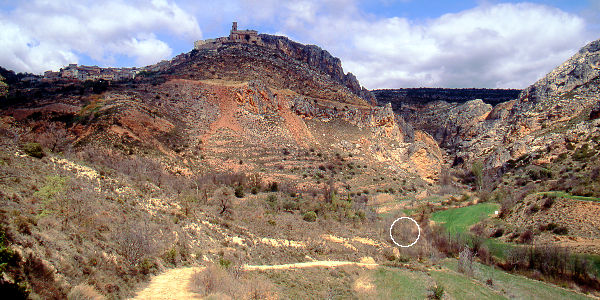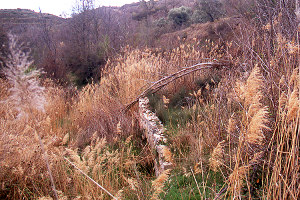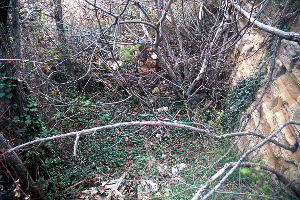
Calasanz

Pictures: 11.IV.2012


Pictures: 11.IV.2012
| Oil mill | Wheat mill |


| 130/629 | Molino harinero | Con barranco, huerto de Antonio Aguilar y Antonio Alegre | Martin Ordas |
| 131/630 | Molino harinero | Con barranco, camino del mismo molino, Lapeña y vasal | José Rami |
This is not entirely in accordance with the Spanish wikipedia pages about Calansanz (no source given):
Estos dos molinos fueron propiedad de la Iglesia hasta la Desamortización del siglo XIX. En 1856 fueron adquiridos por José Rami Cambray y su esposa, quienes al año siguiente compartieron la propiedad con otros catorce vecinos de Calasanz.
En 1917 se hizo cargo el último molinero procedente de Huesca, contratado para poner en marcha, además, una mini-central hidráulica que comenzó a funcionar en 1923 por espacio de unos 25 años.
Acabada la guerra civil, y con la electrificación rural, se inició el declive de los antiguos molinos harineros que fueron desplazados por las modernas fábricas de harina por cilindros, movidas ya por energía eléctrica. Los molinos de Calasanz se cerraron a mediados de la década de los cuarenta del siglo XX.
En la actualidad no quedan en pie ninguno de los 2 molinos, conservándose únicamente partes de la antigua balsa y algunos restos de su estructura.
Translation
Until the Desamortización of the 19th century both these mills were owned by the Church. In 1856 they were acquired by José Rami Cambray and his wife, who in the next year shared the ownership with 14 other people in Calasanz.
In 1917 the last miller, coming from Huesca, took command and was also charged to install a small powerstation which ran from 1923 for about 25 years.
After the civil war came the electrification of the rural communities and that meant also the decline of the old wheat mills. They were replaced by new mills using cilinders driven by electricity. The mills of Calasanz were shut down in the mid 1940s.
Nowadays neither of both mills stands upright and only small fragments of the constructions and the old pond are preserved.



† Published by Servicio de Patrimonio Etnológico Lingüístico y Musical — Diputación General de Aragón Edición Electrónica — 2003 (link to the e-book, latest check II.2019)
| Oil mill | Wheat mill |